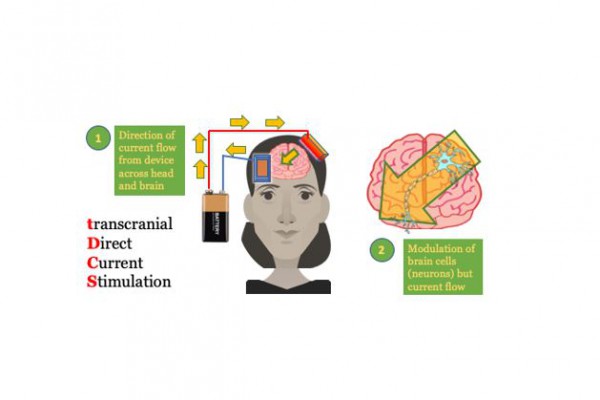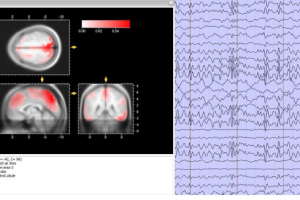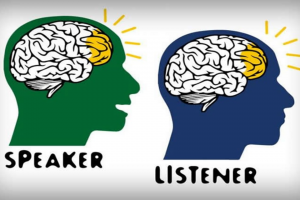Addiction’s Common Ground: A Universal Brain Circuit Revealed
Transcranial Direct-Current Stimulation (tDCS) is a portable, wearable brain stimulation technique that delivers a low electric current to the scalp. A fixed current between 1 and 2 mA is typically applied1. tDCS works by applying a positive (anodal) or negative (cathodal) current via electrodes to an area. tDCS is a neuromodulation technique that produces immediate and lasting changes in brain function. The position of the anode and cathode electrodes on the head is used to set how current flows to specific brain regions.
The current delivered by tDCS is NOT strong enough to trigger an action potential in a neuron; instead its “sub-threshold” changes the pattern of already activity neurons. Think of the brain as active, trying to do or learn something, and tDCS coming along to boost this ongoing activity. At the cellular level, tDCS changes neuronal firing and by strengthening synaptic transmission between neurons by augmenting synaptic plasticity which is, in turn, the cellular basis of learning. tDCS is often combined with training.
Some clinical applications tDCS is currently being explored for are depression, schizophrenia, aphasia, addiction, epilepsy, chronic pain (migraine, fibromyalgia), attention, and motor rehabilitation. tDCS is also used for non-medical wellness applications, for example accelerated learning, focus, relaxation, and meditation.
What does the transcranial Direct Current Stimulation (tDCS) device look like
tDCS devices are small battery powered devices. There is usually a control panel that allows you to program the device (to set the duration and intensity of stimulation). Electrodes are placed on the head and held in place by headgear — usually an elastic strap. A cable connects each electrode to the stimulator. When the stimulator is turned on, current flows from the device to the electrode, and subsequently through the brain. Professional grade stimulators have many features that help ensure stimulation is tolerable and reliable. This includes an impedance meter and a current meter.
What are the side-effects of transcranial Direct Current Stimulation (tDCS)?
Research on the side-effects of tDCS is ongoing, but so far the established side-effects are minor, and restricted to the electrode location. They include temporary skin redness, itching, and tingling. Other suggested side-effects of tDCS include headache, nausea, and dizziness. It should be noted that these latter three side-effects have been illustrated to occur at nearly the same rate as sham stimulation (fake stimulation)8 When tDCS is applied inadequately, other side-effects can occur such as a phosphene which is a temporary, non-dangerous flash of light. This can occur if electrodes are placed too close to the eye. Additionally, incorrect tDCS administration can elicit standard skin burns. There is no scientific evidence that demonstrates lasting injury or irreversible side-effects from tDCS. Nonetheless it should be noted that all of the tolerability and safety data on tDCS comes from controlled human trials using specialized equipment and strictly controlled protocols (e.g., limiting current duration, number of sessions).
What does transcranial Direct Current Stimulation (tDCS) feel like?
During tDCS, most people will feel a mild tingling, prickling, itching, or warmth. These sensations are not painful and go away when stimulation stops. However the “tolerability” of tDCS depends on the quality of accessories, set-up procedures, and using an intensity (few mA) and duration (tens of minutes) consistent with tDCS standards.
Can tDCS treat Anxiety?
The anxiety reduction effects of tDCS have been reported in several clinical trial from top medical center. In the USA, tDCS is not approved for treatment of medical anxiety. Techniques related to tDCS, such as transcranial Alternating Current Stimulation (tACS) have shown promise for anxiety in clinical trials. Another related technique Cranial Electrotherapy Stimulation (CES) is FDA cleared for Anxiet.
Can tDCS treat depression?
Several clinical trials have reported tDCS can treat depression. tDCS also has much less side effects than drugs. In the USA, tDCS is not approved for the treatment of depression. In much of the world, including across Europe, tDCS is approved for treatment of depression.
What are the benefits of tDCS?
tDCS is used for many different applications that involve changing the brain to influence how people think or feel. tDCS is often combined with some other form of activity or training, with the goal of tDCS boosting that specific brain activity. tDCS has been shown to make people learn faster. For example, tDCS can enhance mindfulness (E-meditation). People are also interested in tDCS to boost “working memory”.





Related Posts